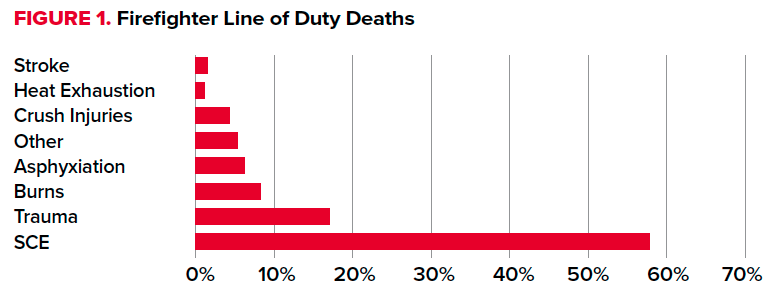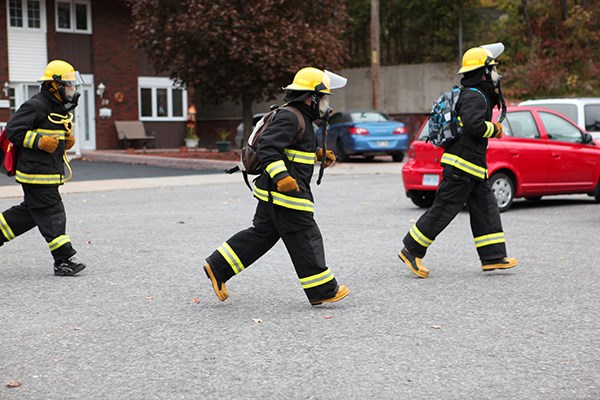The top cause of line-of-duty deaths among firefighters is not trauma, burns, or asphyxiation from smoke. It is sudden cardiac events. EMS directors can have a profound impact on the health and longevity of firefighters simply by implementing simple steps to protect against cardiac emergencies.
Editor's note: This article is adapted from the author's poster presentation at EMRA Case-Con 2018.
Sudden cardiac events (SCEs) are the leading cause of firefighter line-of-duty deaths and represent a significant risk for morbidity in the occupation. Many firefighters exhibit risk factors with concomitant elevated morbidity and mortality rates. Stations must implement evidence-based medicine in regular practice to prevent SCEs.1-7 The purpose of this case study is to bring attention to the issue of sudden cardiac events. It is also vital to seek solutions that can be readily implemented in station protocols, for both voluntary and paid professional staff.
Case Description
A 62-year-old male volunteer firefighter was completing a medical call when he complained of rapidly elevating pressure in his head. He collapsed on the scene. His partner immediately performed CPR, defibrillated the patient twice, and activated emergency medical services.
Upon hearing "Firefighter down!" broadcast on the emergency channel, paramedics returned to the scene to assist with the resuscitation. The patient was determined to be in full cardiac arrest and without vitals for approximately 6 minutes.
The patient was stabilized and transported to a trauma center. His troponins were elevated, and ECG demonstrated ST elevations in the anterior leads. He underwent a double coronary artery bypass graft (CABG) procedure on the left anterior descending artery. The remainder of his hospital course was unremarkable. The patient was able to return to limited duty after 3 weeks of rehabilitation. He was at full-duty status after an additional 2 months of recuperation.
The firefighter's successful resuscitation was directly attributed to the first responders' rapid actions — particularly his partner's extraordinary reaction in her first "Doctor 100" call.
Discussion
SCEs are the most common causes of firefighter line-of-duty deaths. For every firefighter death from SCEs, 17 additional firefighters survive cardiovascular events. Most incidents occur while responding to calls or within 24 hours afterward, and SCEs are associated with exertion 98% of the time. Poor diet, lack of conditioning, and age are significant risk factors.

Additionally, up to 88% of firefighters are obese, leading to increased risk of metabolic syndrome and SCEs.1-4 Key recommendations were developed to reduce morbidity and mortality from SCEs. These include:4-6
- Provide annual medical examinations consistent with the National Fire Protection Association (NFPA) 15827 guidelines and be cleared for duty.
- Mandate regular participation in fitness programs tailored to FFs.
- Educate stations on preparing healthful meals.
- Monitor FFs during and up to 24 hours post-event.
Clinical Significance
SCEs account for a major cause of morbidity and mortality among firefighters. Nearly half of all LOD deaths have been from SCEs, with the average occurring at 45 years of age.8 As a comparison, the average age of sudden cardiac death in the U.S. is 65.6 years for males and 72.0 years for females.9 It is therefore essential for each station to implement preventive, evidence-based medical measures. By taking recommended precautions, risk of SCEs can be significantly mitigated.1-7
While the Florida Heart and Lung Bill (Statute 112.18)10 provides worker's compensation benefits for death or disability from SCEs that are thought to be incurred in the line of duty, risk mitigation is a preferable route, particularly for preventable causes. Emergency medical service directors can have a profound impact by implementing the steps outlined above as part of their occupational health duties to ensure the firefighters under their superintendence experience fewer SCEs.11
Acknowledgements
Special thanks to the Putnam County, Florida, Volunteer Fire Departments for their assistance in this case report.
References
1. National Fire Protection Association. Firefighter fatalities in the United States. https://www.nfpa.org/News-and-Research/Data-research-and-tools/Emergency-Responders/Firefighter-fatalities-in-the-United-States.
2. Sen S, Palmieri T, Greenhalgh D. Cardiac fatalities in firefighters: An analysis of the U.S. Fire Administration Database. J Burn Care Res. 2016;37(3):191-195.
3. Smith DL, Barr DA, Kales SN. Extreme sacrifice: Sudden cardiac death in the U.S. Extreme Physiol Med. 2013;2(1):6.
4. Smith DL, Liebig JP, Steward NM, Fehling PC. Sudden cardiac events in the fire service: Understanding the cause and mitigating the risk. https://www.skidmore.edu/responder/documents/DHS-Sudden-Cardiac-Events-Report.pdf.
5. Haddock CK, Poston WSC, Jahnke SA, for the National Volunteer Fire Council. Addressing the epidemic of obesity in the United States fire service. https://pdfs.semanticscholar.org/ab9f/fb57c9c3e451c438d6b330a72bd4fa3b6576.pdf.
6. Harding RT. Volunteer fire departments face hurdles in improving members’ health. Fire Engineering, 170 (11 Supplement). Retrieved from https://fireengineering.com/articles/print/volume-170/issue-11/supplement/firefighter-wellness/how-to-improve-the-health-of-volunteer-firefighters.html.
7. National Fire Protection Association. NFPA 1582. Standard on comprehensive occupational medical program for firefighters.
8. Smith DL, Matias A. Firefighting and on-duty cardiac deaths. JEMS. Nov. 12, 2018.
9. American Heart Association. Heart disease and stroke statistics 2018 at a glance.
10. Florida Legislature. The 2018 Florida Statutes. http://www.leg.state.fl.us/statutes/index.cfm?App_mode=Display_Statute&URL=0100-0199/0112/Sections/0112.18.html.
11. National Association of EMS Physicians. Guide for preparing medical directors. https://www.nhtsa.gov/people/injury/ems/2001GuideMedical.pdf.



